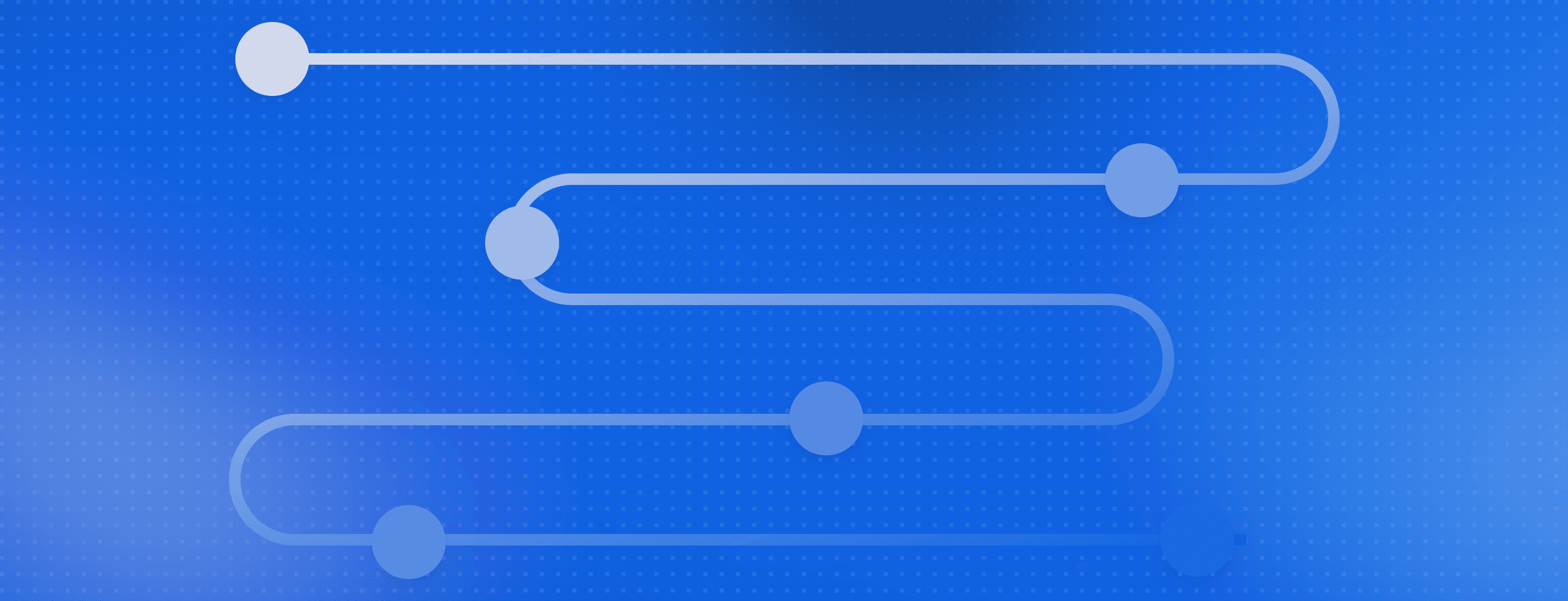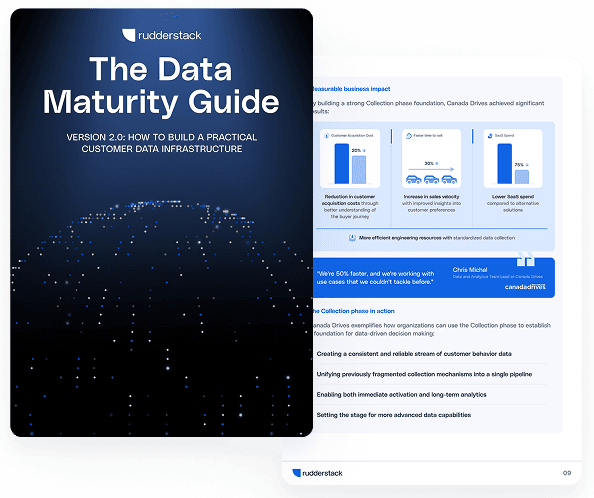Data onboarding: How to streamline your process

Every day, valuable customer data sits trapped in disconnected systems, like CRMs, marketing platforms, and support tools, preventing teams from acting on a complete, accurate view of the customer. Without effective data onboarding, these insights stay locked away, slowing down personalization, analytics, and business decisions.
Data onboarding bridges this gap by transforming raw, fragmented data into a unified, usable format across your stack. When done right, it accelerates time-to-value, ensures data quality, and lays the foundation for real-time engagement and informed strategy.
In this article, we'll break down the key steps of the onboarding process, highlight common pitfalls, and share best practices to help you streamline integration while maintaining data accuracy, governance, and compliance.
Main takeaways:
- Data onboarding is the foundation for turning external and third-party data into usable, governed assets for analytics, personalization, and operations
- Streamlined onboarding reduces time-to-insight, minimizes errors, and ensures compliance with regulations like GDPR and CCPA
- Automating data validation, consent tracking, and transformation workflows improves quality and scalability
- Identity resolution is critical for creating unified customer views and avoiding duplicate or fragmented records
- Tools like RudderStack offer real-time ingestion, cloud-native integration, and customizable transformations to modernize your data onboarding pipeline
What is data onboarding?
Data onboarding is the systematic process of importing, transforming, and integrating external data into your organization's systems. This process enables you to connect offline or third-party data with your digital infrastructure, making it available for analytics, personalization, and operations.
The data onboarding process typically involves collecting data from external sources, mapping it to your internal schemas, validating quality, and finally making it accessible to downstream systems. When done efficiently, it creates a unified view of information that drives better business decisions.
Common scenarios requiring data onboarding include:
- CRM migrations
- Third-party vendor integrations
- Customer data imports
- Product launches with new data sources
- Consolidating information after mergers
Why does data onboarding matter?
The volume and complexity of data sources continue to grow exponentially. Without efficient data onboarding, this valuable information remains trapped in silos, unusable for driving business value.
📊 Did you know?
Global data creation is projected to soar from 149 zettabytes in 2024 to over 394 zettabytes by 2028, making streamlined onboarding essential to keep pace with data growth.
Poor onboarding creates bottlenecks that delay analytics projects and decision-making. When data takes weeks to become available, business opportunities may be missed.
Privacy regulations like GDPR and CCPA have also raised the stakes. Proper data onboarding ensures compliance from the moment data enters your environment, reducing legal and reputational risks.
A streamlined data onboarding process sets the foundation for all downstream data initiatives. Get this right, and your analytics, personalization, and operational use cases will deliver more accurate, timely results.
Key benefits of streamlined data onboarding
Streamlined data onboarding offers more than just operational efficiency; it unlocks faster insights, better personalization, and stronger data governance across your organization. Let's explore the key benefits here.
1. Faster delivery of insights
Efficient data onboarding dramatically reduces the time between data collection and business value. You can launch new analytics projects or update dashboards in hours rather than weeks.
Real-world impact includes faster market response, more agile product development, and timely customer engagement. Each day saved in the data onboarding process translates to a competitive advantage.
2. Reduced errors and improved quality
Manual onboarding processes are prone to human error. Automation and standardization minimize mistakes like:
- Field mapping errors
- Incomplete record transfers
- Format inconsistencies
- Duplicate entries
These improvements cascade throughout your data stack, leading to more trustworthy analytics and better business decisions.
3. Enhanced governance and compliance
Structured onboarding embeds governance directly into your data pipeline from the moment information enters your system. This approach establishes critical controls that include:
- Consent tracking: Capturing and maintaining user permissions
- Data lineage: Documenting where data originated
- Access controls: Managing who can use sensitive information
- Audit trails: Recording all transformations and uses
These capabilities make regulatory compliance significantly easier to maintain and demonstrate to auditors.
💡 Tip: Create a standardized data onboarding checklist that includes privacy review steps for each new data source you integrate.
The step-by-step guide to an efficient data onboarding workflow
An efficient data onboarding process follows these key steps:
1. Collection and consolidation
Begin by extracting data from source systems through APIs, file imports, or direct database connections. The method depends on your source systems and frequency requirements.
- API-based extraction: Ideal for ongoing, automated data flows
- Batch file imports: Suitable for periodic, large-volume transfers
- Database connections: Best for one-time migrations or internal sources
For customer onboarding data collection, focus on capturing complete profiles that include consent information and source documentation.
2. Data preparation and cleansing
Raw data requires transformation before it can be used effectively. This stage includes:
- Standardizing formats and units
- Removing duplicates
- Filling or flagging missing values
- Correcting obvious errors
Quality checks at this stage prevent bad data from contaminating your systems.
3. Identity resolution and matching
Connect incoming records to existing entities in your database. This might use:
- Deterministic matching: Based on unique identifiers like email addresses or customer IDs
- Probabilistic matching: Using multiple fields to establish likely connections when exact matches aren't available
The goal is to create a unified view without creating duplicates or mismatches.
Ready to modernize your onboarding pipeline? Request a demo to see how RudderStack can help streamline your process.
4. Validation and testing
Before making onboarded data widely available, verify its accuracy and completeness through:
- Sample testing against source data
- Automated quality checks against defined rules
- Business logic validation
- Volume and distribution analysis
Set clear quality thresholds that must be met before data proceeds to the next stage.
5. Integration and monitoring
Finally, load validated data into destination systems and establish ongoing monitoring to ensure continued quality and freshness.
- Configure regular refresh cycles
- Set up alerts for quality issues
- Document the entire process for governance
- Track usage patterns to optimize future onboarding
Best practices in data onboarding effectively
Implement these data onboarding best practices to maximize efficiency and quality:
1. Automate quality validation
Build automated checks directly into your data onboarding process to catch issues before they propagate downstream. These validation routines should run automatically at ingestion and verify:
- Data types and formats
- Value ranges and distributions
- Referential integrity
- Business rule compliance
Automation catches errors early and ensures consistent quality across all data sources.
2. Implement real-time consent management
Modern privacy and security requirements demand careful tracking of user consent. Integrate consent management directly into your onboarding workflow by:
- Capturing consent metadata with each record
- Maintaining an audit trail of consent changes
- Enforcing consent-based access controls
- Enabling easy deletion or anonymization when requested
This approach supports compliance while maintaining data utility.
3. Establish clear ownership and roles
Define who is responsible for each aspect of data onboarding by creating clear accountability across your organization.
Establish a RACI matrix (Responsible, Accountable, Consulted, Informed) for key onboarding stages, including extraction, transformation, validation, and integration. Document these responsibilities in your data governance framework to prevent bottlenecks and ensure seamless handoffs between teams during the onboarding workflow. Be sure to clarify the following:
- Data engineers: Pipeline development and maintenance
- Analytics engineers: Schema design and quality validation
- Compliance teams: Privacy and regulatory oversight
- Business stakeholders: Requirements and acceptance criteria
Clear ownership prevents gaps and ensures accountability throughout the process.
How to select the right data onboarding tools and methods
The right data onboarding tools can dramatically impact efficiency and outcomes. Consider these approaches:
1. Real-time vs. batch processing
| Approach | Best for | Example use case |
|---|---|---|
| Real-time | Time-sensitive data | Customer activity streams |
| Batch | Large volumes, periodic updates | Monthly vendor files |
Choose real-time processing when immediacy matters most, such as for user authentication flows, fraud detection, or personalized recommendations that require instant data availability.
Batch processing often provides better efficiency for large volumes by optimizing resource utilization, reducing processing costs, and enabling thorough validation before data reaches production systems.
The right approach depends on your specific latency requirements, infrastructure capabilities, and the downstream systems consuming the data.
2. Code-first transformation capabilities
Look for data onboarding solutions that support custom transformation logic. This gives engineers the flexibility to handle complex data preparation requirements without workarounds.
RudderStack's JavaScript and Python transformations enable precise control over data cleaning, enrichment, and formatting during the onboarding process.
3. Cloud-native integration
Modern data onboarding tools should integrate seamlessly with your cloud data warehouse or lake. This approach centralizes your data while maintaining governance and security.
Leading data onboarding companies now offer direct warehouse integration, eliminating the need for additional storage layers or data copies.
How to continuously improve your data onboarding strategy
Treat data onboarding as an evolving practice rather than a fixed process:
- Track metrics like onboarding time, error rates, and data freshness: Measure time-to-completion for each pipeline stage, monitor validation failure percentages, and verify how quickly new data becomes available to end users
- Gather feedback from data consumers about quality and completeness: Establish regular check-ins with analytics teams, create simple feedback mechanisms within dashboards, and document specific use cases where data gaps are identified
- Regularly review and update your onboarding workflows: Schedule quarterly process audits, implement version control for transformation logic, and document each iteration to maintain institutional knowledge
- Stay current with new data onboarding tools and techniques: Join data engineering communities, evaluate emerging solutions against your specific requirements, and run small proof-of-concept projects before full implementation
Implement a continuous improvement cycle with clear ownership for each enhancement initiative and measurable success criteria to drive meaningful progress.
Common data onboarding challenges
Even mature data teams face hurdles when onboarding new data sources. These common challenges can slow down integration, reduce data quality, and create compliance risks if left unaddressed.
1. Legacy systems and data silos
Older systems often lack modern export capabilities or APIs. Extracting data may require custom scripts or manual processes that slow down onboarding.
Organizational silos compound this problem when different departments control access to their data. Breaking down these barriers requires both technical solutions and cross-functional collaboration.
2. Format inconsistencies
External data rarely arrives in your preferred format, creating immediate integration challenges. Common inconsistencies include structural problems (CSV vs. JSON), semantic differences in how fields are labeled, and quality variations across sources. These format mismatches typically require custom transformation logic before the data becomes usable in your environment. These may be:
- Different date formats (MM/DD/YYYY vs. DD/MM/YYYY)
- Varying field names for identical concepts
- Inconsistent units of measurement
- Character encoding issues
Resolving these differences requires transformation logic that standardizes formats while preserving data integrity.
3. Security and privacy requirements
Onboarding sensitive data introduces additional complexity that requires careful handling throughout the pipeline. You must ensure:
- Secure transfer methods (encrypted connections)
- PII identification and protection
- Consent verification and management
- Compliance with industry regulations
These requirements are essential, but can slow down the data onboarding process if not properly integrated into your workflow.
Streamline data onboarding with RudderStack
Onboarding new data shouldn't be a bottleneck. With the right tools and workflows, you can move from raw input to reliable insights—fast. RudderStack helps you build a structured, scalable onboarding process with automated validation, real-time transformations, and clear data lineage from end to end.
Instead of spending hours debugging broken pipelines or chasing down schema mismatches, your team can focus on what matters: using data to drive impact. Reusable templates and self-service capabilities reduce engineering lift while maintaining high governance standards and data quality.
Want to accelerate onboarding without compromising control? Request a demo to see how RudderStack simplifies the process across your entire stack.
FAQs
What does the data onboarding process involve?
The data onboarding process includes collecting external data, transforming it to match your requirements, validating quality, resolving identities, and integrating it with your existing systems.
Which data onboarding tools work best for customer data?
Look for data onboarding tools that offer strong identity resolution, privacy controls, and integration with your existing customer data infrastructure.
How can I measure the success of my data onboarding implementation?
Track metrics like time-to-insight, error rates, data completeness, and business impact of the onboarded data to measure success.
Published:
July 7, 2025

Data collection crossroads: When to use RudderStack or Google Tag Manager (or both)
In this post, we’ll review three options for how to implement RudderStack with Google Tag Manager, based on experience we’ve gathered across thousands of implementations.

Data integration framework: Components and best practices
A well-designed data integration framework can unify your data architecture, enabling automated pipelines, reducing inconsistencies, and providing a single source of truth for analytics and operations.

Webhook vs. API: What's the difference and when to use each?
Learn when to use APIs vs webhooks for customer data integrations. Compare pull vs push models, tradeoffs in latency, reliability, and control, and how combining both with RudderStack delivers real-time, flexible data flows.






